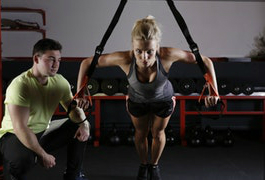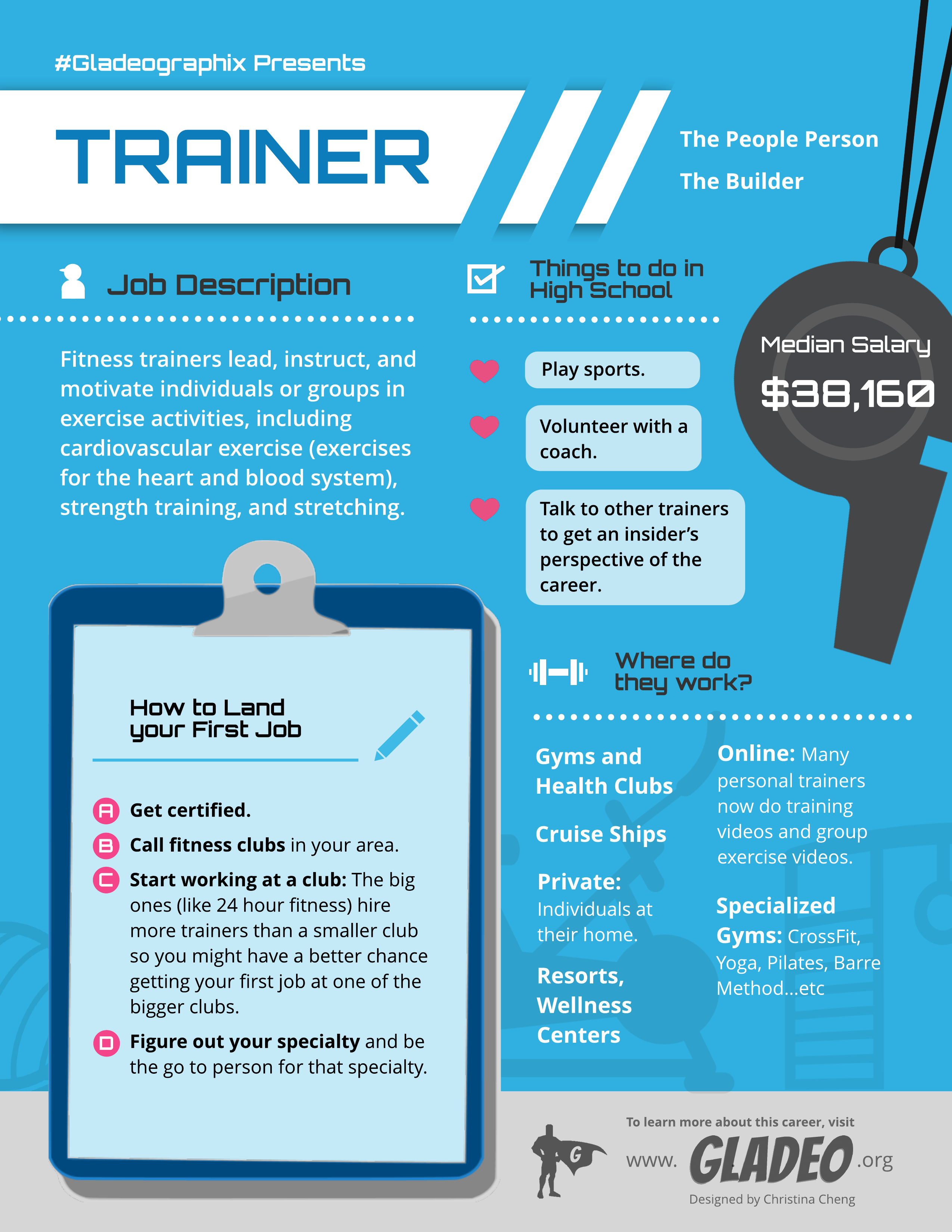Focos
Entrenador personal, entrenador privado, instructor de fitness, instructor de fitness en grupo, instructor de ejercicios en grupo, director de fitness, nutricionista certificado en fitness.
Los entrenadores físicos dirigen, instruyen y motivan a personas o grupos en actividades físicas, incluyendo ejercicios cardiovasculares (ejercicios para el corazón y el sistema sanguíneo), entrenamiento de fuerza y estiramientos.
- Establecimiento de relaciones
- Progresión: Ver la progresión de tu cliente y la tuya propia.
- Ayudar a las personas a conocer su propio cuerpo.
- Aprender de tus clientes
- No es un entorno de oficina.
- Autonomía y control: tú controlas cuánto quieres trabajar o cuán poco quieres hacerlo.
- Ayudar a las personas a estar sanas: Ayudar a los clientes propensos a la diabetes, la obesidad y las enfermedades coronarias a superar sus problemas de salud.
- Marcar la diferencia en la vida de las personas: un entrenador es un motivador. Ayudar a alguien a estar sano y orgulloso de su cuerpo transforma vidas.
Entrenadores físicos
- Evalúa el nivel de forma física actual, los objetivos personales y las habilidades de sus clientes. Algunos quieren perder peso, otros quieren ganar fuerza y otros quieren entrenar para alcanzar un objetivo deportivo.
- Diseña y lleva a cabo rutinas de entrenamiento específicas para las necesidades de sus clientes.
- Explica y hace cumplir las normas y reglamentos de seguridad en materia de deportes, actividades recreativas y uso de equipos de ejercicio.
- Proporciona a los clientes información o recursos sobre nutrición, control de peso y cuestiones relacionadas con el estilo de vida.
- Supervisa el progreso de los clientes y adapta los programas según sea necesario.
- Presta primeros auxilios en caso de emergencia si es necesario.
Instructores de fitness grupales y especializados
- Muestra cómo realizar diversos ejercicios y rutinas.
- Observa a los clientes mientras hacen ejercicios y les muestra o les explica las técnicas correctas para minimizar las lesiones y mejorar su forma física.
- Planifican y coreografían sus propias clases. Eligen la música adecuada para su clase y crean una rutina. Algunos pueden enseñar rutinas pre-coreografiadas que fueron creadas originalmente por empresas de fitness u otras organizaciones (por ejemplo, Zumba).
- Ofrece ejercicios alternativos durante los entrenamientos o clases para diferentes niveles de aptitud física y habilidad.
- Presta primeros auxilios en caso de emergencia si es necesario.
• Algunos ejemplos de especialidades son Pilates, Yoga, CrossFit, TRX, etc.
Los entrenadores e instructores de fitness que trabajan en un centro suelen realizar diversas tareas además de sus funciones relacionadas con el fitness, como atender la recepción, inscribir a nuevos socios, ofrecer visitas guiadas por el centro de fitness, redactar artículos para boletines informativos, crear carteles y folletos, y supervisar las zonas de musculación y de equipamiento cardiovascular.
Los directores de fitness supervisan los aspectos relacionados con el fitness de un gimnasio u otro tipo de club de salud. A menudo se encargan de tareas administrativas, como programar sesiones de entrenamiento personal para los clientes o crear programas de incentivos para el entrenamiento. A menudo seleccionan y encargan el equipo de fitness para sus instalaciones.
- Habilidades de escucha
- Paciencia
- Capacidad analítica
- Persistencia
- Capacidad de organización
- Habilidades físicas
- Habilidades motivacionales
- Comprensión del cuerpo
- Conocimientos de nutrición, biología y fisiología.
- Gimnasios y clubes deportivos
- Gimnasios especializados: CrossFit, yoga, pilates, método Barre, etc.
- Resorts, centros de bienestar
- Cruceros
- En línea: muchos entrenadores personales ahora graban vídeos de entrenamiento y ejercicios en grupo. Es una forma de promocionarse y crear otras fuentes de ingresos.
- Privado: Personas en su domicilio.
- Esencialmente, eres un empresario: además de ser muy competente en tu área de especialización en fitness, tener éxito como entrenador significa tener éxito en los negocios. No puedes depender de los gimnasios para que te recomienden clientes. Tienes que crear tu propia marca y luego idear una buena estrategia de marketing y ponerla en práctica. Tú eres responsable del número de clientes que tienes y de cómo te mantienes en contacto con ellos.
- Debes estar al día de las nuevas tecnologías y tendencias.
- Debes saber más que solo entrenamiento físico. La gente quiere saber sobre nutrición, técnicas terapéuticas.
- Trabajará en horarios irregulares: noches, fines de semana, no todos los días igual.
- Podría ser temprano por la mañana antes del trabajo, o tarde después del trabajo.
En crecimiento y con gran demanda. Cada vez más personas se suben al tren del ejercicio físico. Saben que el ejercicio y la nutrición son claves para una salud duradera. La medicina preventiva se está extendiendo y el ejercicio es una parte muy importante de ella.
- ¡Me encantaba el fitness y el ejercicio!
- ¡Me encantaba estar activa!
- Los entrenadores físicos deben tener un título de secundaria o GED y completar un certificado de educación superior, un título de asociado o una licenciatura en ciencias del ejercicio, educación física, kinesiología, recreación y fitness, o un título relacionado.
- El 18 % de los formadores son autónomos, por lo que muchos estudiantes también estudian empresariales.
- Entre los programas de certificación de entrenador personal más populares se incluyen ISSA-CPT (que señala que con una hora de estudio al día los alumnos pueden terminar en 10 semanas) y Instructor certificado de fitness en grupo ACE (que ofrece planes de estudio flexibles de 3 a 6 meses).
- Los cursos comunes incluyen:
- Kinesiología aplicada
- Desarrollo de programas de formación
- Ciencia del ejercicio
- Anatomía humana
- Nutrición
- Fisiología
- Control del peso
- Los temas especializados incluyen el entrenamiento de clientes con asma, enfermedades cardíacas, artritis u otras afecciones físicas.
- Hay docenas de certificaciones disponibles de múltiples organizaciones (véase Recursos > Sitios web para obtener una lista completa).
- La Comisión Nacional para la Certificación de Agencias (NCCA) acredita a las organizaciones que ofrecen certificaciones.
- Los empleadores, como gimnasios y clubes deportivos, suelen exigir que sus entrenadores estén certificados antes de comenzar a trabajar. Es posible que también tengan que realizar algunas tareas supervisadas antes de entrenar a clientes de forma individual.
- Los requisitos para obtener la certificación de entrenador suelen incluir también la realización de cursos de RCP y DEA (desfibrilador externo automático).
Haga clicaquípara ver la lista de programas acreditados.
- Asiste a muchas clases de fitness y nutrición en la escuela o en tu tiempo libre. Considera la posibilidad de participar en programas deportivos o atléticos.
- Habla con los entrenadores y pregúntales cómo empezaron.
- Piensa en qué tipo de fitness te gustaría especializarte en función de tus intereses y dónde te gustaría trabajar después de graduarte.
- Perfecciona tus habilidades sociales y desarrolla tu talento para el servicio al cliente.
- Crea tu «persona laboral» y desarrolla tus habilidades de escucha y comunicación verbal.
- Mira tutoriales en YouTube, lee blogs y mantente al día de las novedades y lo que está de moda.
- ¡Haz amigos con otros entrenadores! Mantén el contacto con tu red y ayúdense mutuamente.
- Aprende de tus compañeros. Haz preguntas y muéstrate dispuesto a explorar nuevos métodos.
- Para aumentar tus oportunidades, obtén certificaciones en más de un área.
- Verywell Fit Las mejores opciones de certificación incluyen:
- Lo mejor para especializaciones adicionales: Consejo Americano de Ejercicio
- Lo mejor para profundizar en la ciencia: Colegio Americano de Medicina Deportiva
- Mejor apoyo a la formación continua: Federación Nacional de Formadores Profesionales
- Lo mejor para personas emprendedoras: Asociación Nacional de Entrenadores Deportivos y de Ejercicio Físico
- 19,6 % con título de secundaria
- 9,6 % con título de asociado
- 33,3 % con título universitario
- 8 % con máster
- 1,2 % con Professional
*Porcentaje de empleados de entre 25 y 44 años en la ocupación cuyo nivel educativo más alto es

- Obtenga la certificación.
- Llama a los gimnasios de tu zona.
- Empieza a trabajar en un gimnasio: los grandes (como 24 Hour Fitness) contratan a más entrenadores que los pequeños, por lo que es posible que tengas más posibilidades de conseguir tu primer empleo en uno de los gimnasios más grandes.
- Descubre cuál es tu especialidad y conviértete en la persona de referencia para esa especialidad.
- Ten en cuenta que los empleadores ven a los formadores como representantes de su marca y reputación, así que infórmate sobre las empresas en las que solicitas trabajo.
- Los empleadores suelen buscar una combinación sólida de talento, profesionalidad y personalidad.
- Ser entrenador personal requiere generar confianza con los clientes. ¡La compatibilidad personal es un factor clave!
- Publica tu currículum en portales de empleo como Indeed y Glassdoor. Echa un vistazo a Craigslist y llama a los gimnasios locales para preguntar también por las oportunidades.
- Lee detenidamente las ofertas de empleo y asegúrate de que cumples todos los requisitos indicados.
- Considera la posibilidad de crear un sitio web para promocionar y comercializar tus servicios (especialmente si estás pensando en trabajar por cuenta propia).
- Si impartes clases en grupo, pregunta a tus alumnos si puedes grabar una sesión para utilizarla en tu sitio web y demostrar tus conocimientos y habilidades.
- Anúnciate en las redes sociales. Ofrece consejos gratuitos y contenido práctico para aumentar tu número de seguidores.
- Profundiza en los detalles de lanzar tu propio negocio para ver si es una opción viable para usted.
- Estudiar Plantillas de currículum para entrenador físico
- Revisar muestra Preguntas de la entrevista con el entrenador físico para hacerse una idea de lo que puede esperar
- Práctica simulacros de entrevistas para que puedas presentarte como una persona capaz y segura de sí misma.
- Manténgase al día sobre las investigaciones científicas y la terminología para poder impresionar a los entrevistadores.
- Crea tu propia marca: Necesitas crear tu propio estilo de entrenamiento y comunicárselo a tus clientes potenciales.
- La verdadera comprensión de la nutrición
- Promocionarse: Yelp, YouTube
- Sé indispensable para tus clientes: ofrece a cada cliente y servicio lo mejor y haz un esfuerzo adicional que otros a menudo no harían.
- Certificaciones de formación continua: Manténgase al día de los métodos y la formación más actuales, basados en investigaciones científicas y técnicas de formación de vanguardia.
- Habla con otros entrenadores y pídeles consejo.
- Utiliza las redes sociales y los boletines informativos por correo electrónico para conectar con tus clientes.
Sitios web
- Academia de Educación Aplicada al Entrenamiento Personal
- ACCIÓN
- Asociación Americana de Aeróbic y Fitness
- Academia Americana de Profesionales de la Salud, el Fitness y la Rehabilitación
- Colegio Americano de Medicina Deportiva
- Consejo Americano del Ejercicio
- Asociación Americana de Certificación Educativa
- Profesionales y Asociados de Fitness Americanos
- Fuente de salud estadounidense
- Asociación de Ejercicio Acuático
- Asociación Universitaria de Entrenadores de Fuerza y Acondicionamiento Físico
- Instituto Cooper para la Investigación Aeróbica
- CrossFit, S.L.U.
- Mentores de fitness
- Asociación Internacional de Acondicionamiento Deportivo
- Asociación Internacional de Ciencias del Deporte
- Academia Nacional de Medicina Deportiva
- Asociación Nacional para la Certificación en Fitness
- Comisión Nacional para la Certificación de Agencias
- Consejo Nacional de Entrenadores Personales Certificados
- Consejo Nacional de Fuerza y Acondicionamiento Físico
- Asociación Nacional de Entrenadores Deportivos y de Ejercicio Físico
- Asociación Nacional de Entrenadores Físicos
- Federación Nacional de Entrenadores Profesionales
- Programa Nacional de Certificación de Pilates
- Asociación Nacional de Fuerza y Acondicionamiento Físico
- Asociación Nacional de Profesionales del Fitness
- Instituto Nacional de Bienestar
- Alianza del Método Pilates
- PTA Global
- Comisión de Certificación en Formación y Bienestar
- Registro estadounidense de profesionales del ejercicio físico
- Escuelas de formación de instructores mundiales
- Alianza de Yoga
Libros
- Anatomía del ejercicio: guía interna de un entrenador para tu entrenamiento, por Pat Manocchia
- Enciende la llama: los secretos para desarrollar una carrera exitosa como entrenador personal, por Jonathan Goodman
- Secretos para diseñar programas exitosos: una guía práctica para profesionales del fitness con una agenda apretada, por Alwyn Cosgrove y Craig Rasmussen
Carreras alternativas:fisioterapeuta, preparador físico, asesor de fitness.
«No hagas este trabajo por el dinero. Hazlo porque estás haciendo algo que te gusta y el dinero llegará con el tiempo».
Fuente de noticias

Empleos destacados

Cursos y herramientas en línea

Expectativas salariales anuales
Los nuevos trabajadores comienzan con un salario de alrededor de 59 000 dólares. El salario medio es de 84 000 dólares al año. Los trabajadores con mucha experiencia pueden ganar alrededor de 110 000 dólares.
Expectativas salariales anuales
Los nuevos trabajadores comienzan con un salario de alrededor de 42 000 dólares. El salario medio es de 61 000 dólares al año. Los trabajadores con mucha experiencia pueden ganar alrededor de 79 000 dólares.







